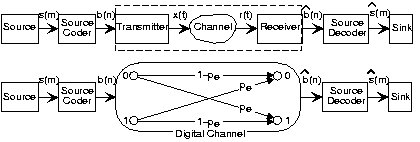| << Chapter < Page | Chapter >> Page > |
Let's review how digital communication systems work within the Fundamental Model of Communication . As shown in [link] , the message is a single bit. The entire analog transmission/reception system, which is discussed in Digital Communication , Signal Sets , BPSK Signal Set , Transmission Bandwidth , Frequency Shift Keying , Digital Communication Receivers , Factors in Receiver Error , Digital Communication System Properties , and Error Probability , can be lumped into a single system known as the digital channel.

Digital channels are described by transition diagrams , which indicate the output alphabet symbols that result for each possible transmitted symbol and theprobabilities of the various reception possibilities. The probabilities on transitions coming from the same symbol mustsum to one. For the matched-filter receiver and the signal sets we have seen, the depicted transition diagram, known as a binary symmetric channel , captures how transmitted bits are received. The probability of error is the sole parameter of the digital channel, and it encapsulates signal set choice, channel properties, and thematched-filter receiver. With this simple but entirely accurate model, we can concentrate on how bits are received.

Notification Switch
Would you like to follow the 'Fundamentals of electrical engineering i' conversation and receive update notifications?